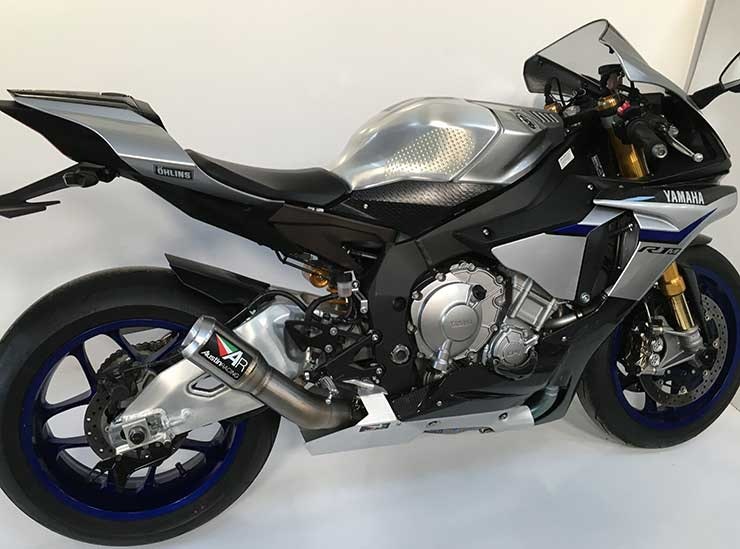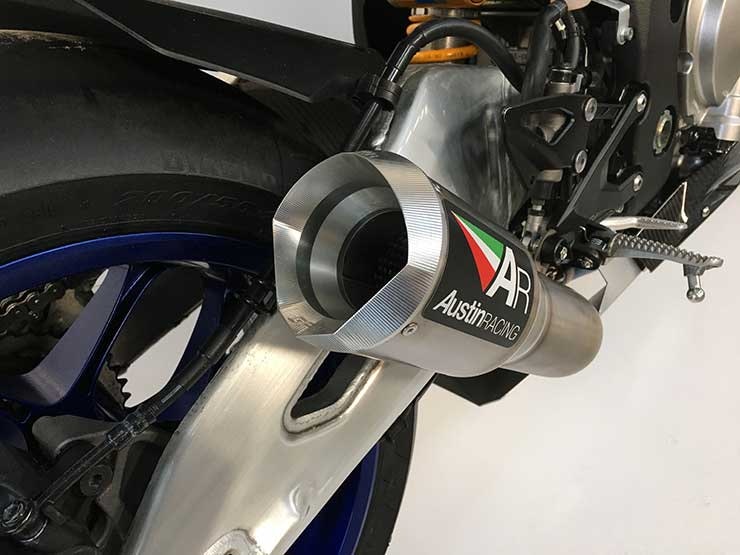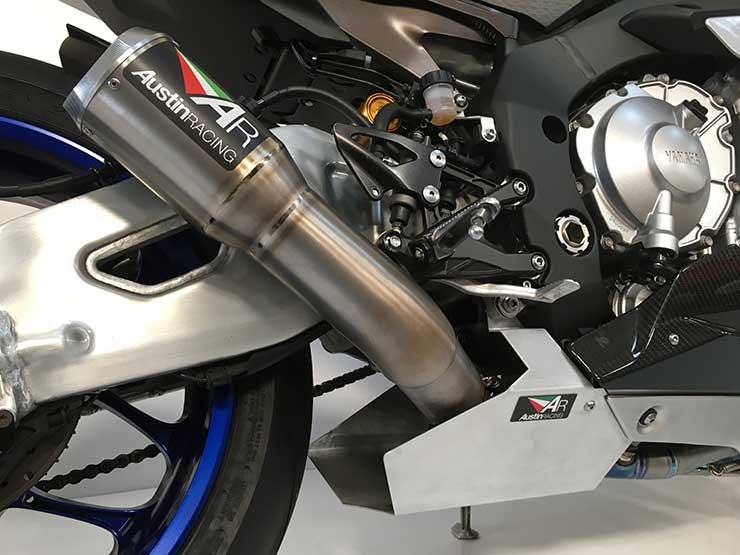Yamaha YZF-R1M (2017) – Long Term Review #1
By Kane Dalton
BikeSocial's former Commercial Manager
14.02.2017
Eazi - Guard
ECU Flash Map
High Flow Air Filter
Yamaha YZF-R1M: First Update
The YZF-R1M is the highly sophisticated and even more trick version of the already sublime and massively capable R1 with upgraded components including carbon fairing, GPS Data Logging and Öhlins Semi Active Electronic Suspension. The standard R1 is priced at £15,599 for 2017 while the R1M is £3,800 more at £19,399.
Our man, Kane Dalton, first tested this motorcycle back in 2015 - the year it was launched - with both road and track elements to the test including use of the 300 circuit at Snetterton. Here's an updated version of that review.
Our bike now has just under 7,000 miles on the clock and over the course of 2017 we'll be documenting any additional parts and their impact on the bikes' performance and we invite you to come along on the journey with us.
When you buy a superbike for the road (or track) you probably wouldn't expect to spend much more money on enhancing its performance, especially one as purposefully developed as the R1M. However, even though the authorised Yamaha optional extra exhaust in made by Solvenian aftermarket parts company, Akrapovic, the first thing I fitted to the bike is the Full Titanium Austin Racing GP1R exhaust system instead. Why I chose Austin Racing
Austin Racing owner, Rich Austin, is a keen sports bike enthusiast and started his own company when he couldn't find the look or sound he wanted from the systems that existed on the market for his own Aprilia RSV4. And so specialist motorcycle performance exhausts company, Austin Racing, was born in 2010.
R&D came in the form of consultation with a friend and a cousin who both worked for McLaren and Mercedes-Benz including developing the F1-style exhaust system for the McLaren P1. So it's true to say that F1 technology is used in Austin Racing systems but such is its secrecy, that when I visited the factory, photography of the jigs was not permitted.
I had heard that all of the Austin Racing systems produce far too much noise to be road legal and that the systems would even fail a track day noise test. So, I spoke to Rich who was happy to test and develop a new system for the market that does not compromise power yet will pass the noise test - and called it the GP1R. With a decibel killer fitted we tested it on his dyno and it measured 105dB.
This is the system fitted to our R1M and happens to be the exact same system that 2014 British Superbike Champion, Josh Brookes, will be running on his Anvil Hire Tag Yamaha R1 race bike in BSB this year. So, if the GP1R is good enough for Josh then it is certainly good enough for the BikeSocial bike.
Non-melting
The exhaust was fitted at Austin Racing so they could check and confirm that it would not melt or burn anything. Why? Because he'd heard that an alternative exhaust system was prone to melting road fairings. After a quick call to his local dealer to confirm where the problem was, Rich and his team were able to shape the pipes to ensure that the GP1R didn't do the same. Once fitted he ran the bike on the dyno to check and all was ok.
When the standard system is removed, it also means you can get rid of the massive (and heavy; 7kg) catalytic converter box. However, this leaves a big ugly space and exposed pipes but never fear because Austin Racing make a belly pan that fills this gap and finishes the bike off well.
Sound testing on Austin Racing's dyno revealed the system produces 110 decibels at 5,500 RPM without the decibel killing baffle! At 110 decibels this level would never pass a track noise test or MOT (insert sad emoji face here).
Fitting a decibel killer is the solution. This is simply a length of pipe that creates a baffle and can be fitted with ease. All it takes is to slot the baffle in to the end can and then insert a screw that holds the baffle in place. Done. When this baffle is in place the bike produces 105 decibels at 5,500 rpm. OK, it's still on on the edge of what might pass at the track or at your MOT but as an added bonus, Rich tells me that this level should drop after the bike has been ridden for a couple of hundred miles as the internal wadding expands which adds to the damping of the noise.
If 105dB is still too much, never fear because Austin Racing have built another link pipe that they also tested on the R1M bringing the level down to 102dB which is a guaranteed pass at the track and the MOT centre. Rich is now offering this pipe as a kit option if you buy any Austin Racing exhaust system.
Active Tuner
There is always a drop off in power when you add any restriction in an exhaust system so I'll be fitting an Active Tuner to compensate - a device that slots into the lambda sensor in the exhaust and feeds information to the ECU.
When adding a decibel killing baffle or swapping out the link pipe, the levels of fuel and air mix change in the exhaust. The Active Tuner will make the necessary adjustments to the keep the fuelling and air mix as close to the base map in the ECU, and it should offer peak power regardless of the link pipe or baffle used. I will post more information on this once it is installed and been tested.
Also on the bike above the standard fit equipment is a high flow BMC air filter c/o R&G Racing, this allows for an increased flow into the air box and can make a couple of extra BHP. Just because 181BHP (at the rear wheel) isn't enough!
The R1M on the PCR Performance Dyno
BikeSocial's YZF-R1M on the PCR Performance Dyno
The ECU on the Yamaha and most bikes are set up with various restrictions, historically riders would add an aftermarket fuelling device like a Power Commander or Bazzaz to adjust the fuelling after fitting an air filter and exhaust system. If you fit a full system without altering the fuelling the bike runs really rough - spluttering and backfiring. It was hard to tap into the standard ECU before which is why racers often upgraded to kit ECU’s which could be mapped direct using specialist hardware.
Things have moved along since that time and it is now easier to map and unlock features and settings in the ECU. The standard map in the Yamaha is restricted (by Yamaha) so adding a Power Commander will only allow you to get the best from what the current ECU settings allow. The best way to get the ultimate performance from the bike is to flash the ECU meaning it's wiped and new software is downloaded - this is standard procedure for race teams.
So to get the optimum performance from our bike off we went to PCR Performance based in Cannock and owned by Paul Curran who is better known for his success as a racer in BSB and Moto2. Curran has been mapping and building race bikes for ten years and is an ECU flash specialist. Following in the footsteps of the BSB paddock, our R1Ms ECU was wiped and Ftecu.com (Flash Tune) was downloaded. Things were about to get interesting!
The dyno at PCR runs a system that measures the power at the back wheel via a drum that spins off the back wheel that feeds the data into the software and makes the calculations. In order to get the best and most consistent comparisons, PCR replaced the sticky Pirelli Diablo Rosso Corsa rear tyre with their control road tyre used on all the bikes that they run on the dyno. The tyre pressure was set at the usual standard road level.
Paul explained that he downloads a base map to the ECU, once the map is in the ECU you can select which sensors you want to keep or turn off based on whether the bikes function is road or race, including RPM limits, fan temperatures etc. We also set the fan kick-in temp down to 90 degrees so it kicks in earlier so the bike doesn't overheat.
Something else the ECU controls is the electronic steering damper, so if you are running a race bike such as in the British Superbike Championship where the rules regulate the amount of electronics permitted, you can turn off the standard electronic steering damper setting if it's been swapped out in favour of a mechanical version.
The flash tuning offers various fuel mapping settings, for example each cylinder can be mapped individually or grouped together to react the same way. Ignition settings include setting up a softer throttle response without compromising the map whereas throttle parameters can be set as the R1M because the bike's has a Throttle-By-Wire meaning the throttle openings can be set at specific RPM’s.
The R1M has automatically adjusted velocity stacks in the airbox so when Paul noticed a slight W-shape in the power graph they bike was producing around 194BHP at the rear wheel. A few tweaks to the velocity stack heights at that RPM not only meant a smoother graph shape but he'd found another 2.5BHP.
Flash Tune have an Blip Assist option that connects via ECU, a two way sensor is fitted on the quickshift bar so you can make clutchless downshifts. This system does not only blip it also reads the others sensors on the bike and makes adjustments. When testing bikes with the downshift function I felt the seamless changes made the bike feel more stable. More about this function in our next update of our longterm R1M.
The standard exhaust was producing 181BHP but after fitting the Austin Racing system the base run was 188BHP. With a few tweaks from Mr Curran, the bike was putting out consistent runs at 196.21BHP. If you want a crank figure you can add 15 – 20%, so that's circa 230 - 235 bhp!!!
Chip Free
To keep the carbon and fairing protected from stone chips we've fitted Eazi-Guard. They supply a strip of cut shapes, you wet the surface place the guard on the bike then squeeze out the excess water and air bubbles which takes far too much patience for a man like me and yes, I admit, in a couple of places the bubbles defeated me but overall it looks great. It's only a plastic film so it'll be interesting to see how to stands the test of time.
The Verdict
When I pulled the bike out of the van in that evening the temptation to take it for a quick blast was too great. I grabbed my gear and jumped on the bike. The sound thundering from the crossplane and new system was unexpected. If I heard the bike before I saw it my first guess would be Desmosedici RR with its race Termignoni, I would not expect to see a Yamaha.
Rich Austin suggested the bike would lose a few decibels after a couple of hundred miles as the wadding expands and beds in. I found myself wondering if the stingers were being set in the next county or if they heard the bike start from the same destination.
A few miles from home I found myself riding next to a highly tuned Nissan GTR, he was obviously running a straight-through system by the thunderous sound. When he rolled off the gas two three-foot blue flames blasted from the back of the car like an after burner. He smiled and gave me a thumbs up when the R1M did the same thing.
I can't wait to get the bike on track and see what the 'teleporter' can do now that it has been mapped. The bike was a missile the first time I rode it and I'm looking forward to seeing just how much difference that extra BHP has made.
Next time… the bike heads to Reactive Parts in Hemel Hempsted where Jamie Whitham will be filming how easy it is to fit aftermarket parts. Tune in to update 2 coming soon.
Share on social media:


